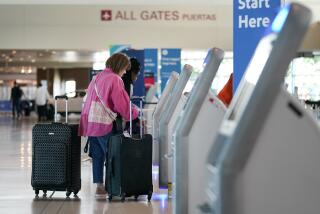FAA Aide Sees Child Safety Seats Costing More Lives
- Share via
WASHINGTON — A Federal Aviation Administration official testified Thursday that requiring the use of child safety seats on commercial airliners would cost more lives than it would save because more families would travel by car, which is more dangerous than flying.
Anthony J. Broderick, the FAA associate administrator for regulation and certification, told a House panel that there is little doubt safety seats would save infant lives in the event of an airplane crash. But he said the agency opposes mandating their use because studies suggest that families would not purchase an additional air fare and would opt instead to make cheaper--and more dangerous--highway trips.
As a House aviation subcommittee listened with obvious disapproval, Broderick said: “Our concern is that while the chance of survival aboard an airplane may be slightly improved, the costs associated with mandating the carriage of a child in a separate seat will divert a significant number of families from our safest form of transportation--air travel--to the far less safe travel by automobile.”
Spurred by public outcry at the deaths of children in recent plane crashes--including three infants and one small child in last year’s Sioux City, Iowa, crash and the death of one infant and injuries to six others in the New York crash of an Avianca jet--the House is considering a bill to mandate the use of safety seats for children under age 2. Under current regulations, children under 2 are allowed to fly free if they sit in an adult’s lap. If safety seats are mandated, parents would have to buy a separate ticket to accommodate them.
The legislation, sponsored by Rep. Jim Lightfoot (R-Iowa), would force the FAA to revise airline operating rules to require that children use safety seats or some other form of in-flight restraint system. The bill would leave it to the Transportation Department to decide whether age and/or weight limits would determine when children would be required to use the restraints.
If the House bill and a companion in the Senate--sponsored by Sen. Christopher S. Bond (R-Mo.) and Sen. John C. Danforth (R-Mo.)--become law, children most likely would be required to occupy an airline seat. That, opponents say, would lead to greater costs for families because the airlines are unlikely to allow children to fly free if they occupy a revenue-producing seat. Airline industry officials estimate that 3.3-million to 4-million children under 2 fly on U.S. domestic flights each year.
Bond visited the House to testify in support of the bill. He called existing airline policies on child safety seats “confusing, vague and frustrating.” One airline, he said, wouldn’t allow his son to sit in an FAA-approved infant car seat even after Bond had purchased a ticket for him.
Regarding the FAA’s arguments that more deaths would occur on the highways because the additional cost would force parents to travel by car, Bond said: “I find this reasoning appalling. If this line of argument were carried to its logical extreme,” other safety measures that increase the cost of an airline ticket could be trimmed. “We wouldn’t require oxygen masks, flame-retardant seats or safety lights on airplanes,” he said.
Quoting a report by adjunct fellows at the Center for the Study of American Business at Washington University in St. Louis, Broderick said that the diversion of families from airliner to highway “could translate into more than 1,600 additional automotive accidents each year and the increase in accidents could result in more than 175 additional disabling injuries and just under five additional deaths each year.”
More to Read
Get the L.A. Times Politics newsletter
Deeply reported insights into legislation, politics and policy from Sacramento, Washington and beyond. In your inbox twice per week.
You may occasionally receive promotional content from the Los Angeles Times.










